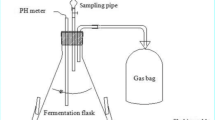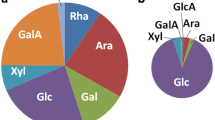Abstract
Sugar beet pulp is a by-product of sugar production and consists mainly of cellulose, hemicellulose and pectin. Its composition is suitable for biological degradation. A possible alternative for the utilization of this material (besides cattle feeding) can be anaerobic methanogenic degradation. It has an additional advantage – biogas production. Beet pulp was treated by a two-step anaerobic process. The first step consisted of hydrolysis andacidification. The second step was methanogenesis. In this paper, observation ofthe process of anaerobic degradation and determination of optimal parameters is discussed. A laboratory-scale model for sugar beet pulp anaerobic biodegradation was operated. Results of model performance have shown very good pulp digestion characteristics. In addition, high efficiency removal of organic matter was achieved. Methane yield was over 0.360 m3 kg-1 dried pulp and excess sludge production was 0.094 g per gram COD added.
Similar content being viewed by others
References
APHA (American Public Health Association) (1992) Standard methods for the examination of water and wastewater. 18th edn. APHA, Washington DC
Dubois M, Gilles KA, Hamilton JK, Rebers PA & Smith F (1956) Colorimetric method for determination of sugars and related substances. Anal. Chem. 28: 350–356
Lane AG (1984) Laboratory scale anaerobic digestion of fruit and vegetable solid waste. Biomass 5: 245–259
Micard V, Renard CMGC & Thibault J-F( 1996) Enzymatic saccharification of sugarbeet pulp. Enzyme and Microbial Technol. 19: 162–170
Miller GL (1959) Use of dinitrosalicyl acid reagent for determination of reducing sugar. Anal. Chem. 31: 426–428
Spagnuolo M, Crecchio C, Pizzigallo MDR & Ruggiero P (1997) Synergistic effects of cellulotic and pectinolytic enzymes in degrading sugar beet pulp. Biores. Technol. 60: 215–222
Voragen AGJ, Oosterveld A, Schols HA & Beldman G (1997) Pectic substances from sugar beet pulp: Extraction and fractionation, structural features, functional properties and enzymic modifi-cation. In: Transformation and Modification of Carbohydrates, Proc. of 4th Int. Workshop on Carbohydrates as Organic Raw Materials, Vienna, Austria, March 20–21:29
Weiland P(1993) One-and two-step anaerobic digestion of solid agroindustrial residues. Water Sci. Technol. 27: 145–151
Zábranská J, Pokorná D & Dohányos M(1991) Isotachophoretic determination of byproducts of anaerobic metabolisms. Sci. Papers of Prague Inst. of Chem. Technol., Prague, Czech Republic F28: 149–157
Author information
Authors and Affiliations
Rights and permissions
About this article
Cite this article
Hutnan, M., Drtil, M. & Mrafkova, L. Anaerobic biodegradation of sugar beet pulp. Biodegradation 11, 203–211 (2000). https://doi.org/10.1023/A:1011139621329
Issue Date:
DOI: https://doi.org/10.1023/A:1011139621329




